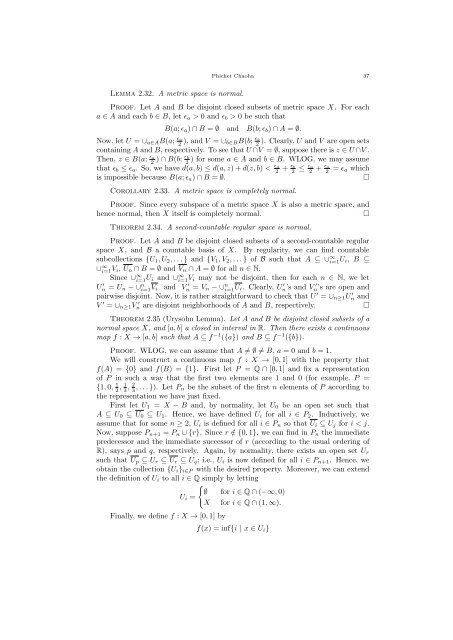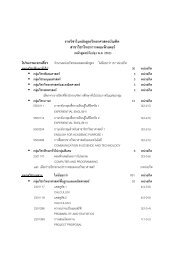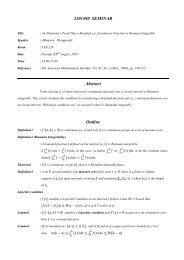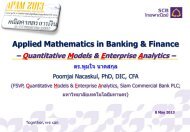Lecture Notes Topology (2301631) Phichet Chaoha Department of ...
Lecture Notes Topology (2301631) Phichet Chaoha Department of ...
Lecture Notes Topology (2301631) Phichet Chaoha Department of ...
You also want an ePaper? Increase the reach of your titles
YUMPU automatically turns print PDFs into web optimized ePapers that Google loves.
<strong>Phichet</strong> <strong>Chaoha</strong> 37<br />
Lemma 2.32. A metric space is normal.<br />
Pro<strong>of</strong>. Let A and B be disjoint closed subsets <strong>of</strong> metric space X. For each<br />
a ∈ A and each b ∈ B, let ϵ a > 0 and ϵ b > 0 be such that<br />
B(a; ϵ a ) ∩ B = ∅ and B(b; ϵ b ) ∩ A = ∅.<br />
Now, let U = ∪ a∈A B(a; ϵ a<br />
2<br />
), and V = ∪ b∈B B(b; ϵ b<br />
2<br />
). Clearly, U and V are open sets<br />
containing A and B, respectively. To see that U ∩V = ∅, suppose there is z ∈ U ∩V .<br />
Then, z ∈ B(a; ϵ a<br />
2<br />
) ∩ B(b; ϵ b<br />
2<br />
) for some a ∈ A and b ∈ B. WLOG, we may assume<br />
that ϵ b ≤ ϵ a . So, we have d(a, b) ≤ d(a, z) + d(z, b) < ϵa 2 + ϵ b<br />
2<br />
≤ ϵa 2 + ϵa 2 = ϵ a which<br />
is impossible because B(a; ϵ a ) ∩ B = ∅.<br />
□<br />
Corollary 2.33. A metric space is completely normal.<br />
Pro<strong>of</strong>. Since every subspace <strong>of</strong> a metric space X is also a metric space, and<br />
hence normal, then X itself is completely normal.<br />
□<br />
Theorem 2.34. A second-countable regular space is normal.<br />
Pro<strong>of</strong>. Let A and B be disjoint closed subsets <strong>of</strong> a second-countable regular<br />
space X, and B a countable basis <strong>of</strong> X. By regularity, we can find countable<br />
subcollections {U 1 , U 2 , . . . } and {V 1 , V 2 , . . . } <strong>of</strong> B such that A ⊆ ∪ ∞ i=1 U i, B ⊆<br />
∪ ∞ i=1 V i, U n ∩ B = ∅ and V n ∩ A = ∅ for all n ∈ N.<br />
Since ∪ ∞ i=1 U i and ∪ ∞ i=1 V i may not be disjoint, then for each n ∈ N, we let<br />
U n ′ = U n − ∪ n i=1 V i and V n ′ = V n − ∪ n i=1 U i. Clearly, U n’s ′ and V n’s ′ are open and<br />
pairwise disjoint. Now, it is rather straightforward to check that U ′ = ∪ n≥1 U n ′ and<br />
V ′ = ∪ n≥1 V n ′ are disjoint neighborhoods <strong>of</strong> A and B, respectively.<br />
□<br />
Theorem 2.35 (Urysohn Lemma). Let A and B be disjoint closed subsets <strong>of</strong> a<br />
normal space X, and [a, b] a closed in interval in R. Then there exists a continuous<br />
map f : X → [a, b] such that A ⊆ f −1 ({a}) and B ⊆ f −1 ({b}).<br />
Pro<strong>of</strong>. WLOG, we can assume that A ≠ ∅ ̸= B, a = 0 and b = 1.<br />
We will construct a continuous map f : X → [0, 1] with the property that<br />
f(A) = {0} and f(B) = {1}. First let P = Q ∩ [0, 1] and fix a representation<br />
<strong>of</strong> P in such a way that the first two elements are 1 and 0 (for example, P =<br />
{1, 0, 1 2 , 1 3 , 2 3 , . . . }). Let P n be the subset <strong>of</strong> the first n elements <strong>of</strong> P according to<br />
the representation we have just fixed.<br />
First let U 1 = X − B and, by normality, let U 0 be an open set such that<br />
A ⊆ U 0 ⊆ U 0 ⊆ U 1 . Hence, we have defined U i for all i ∈ P 2 . Inductively, we<br />
assume that for some n ≥ 2, U i is defined for all i ∈ P n so that U i ⊆ U j for i < j.<br />
Now, suppose P n+1 = P n ∪ {r}. Since r /∈ {0, 1}, we can find in P n the immediate<br />
predecessor and the immediate successor <strong>of</strong> r (according to the usual ordering <strong>of</strong><br />
R), says p and q, respectively. Again, by normality, there exists an open set U r<br />
such that U p ⊆ U r ⊆ U r ⊆ U q ; i.e., U i is now defined for all i ∈ P n+1 . Hence, we<br />
obtain the collection {U i } i∈P with the desired property. Moreover, we can extend<br />
the definition <strong>of</strong> U i to all i ∈ Q simply by letting<br />
{<br />
∅ for i ∈ Q ∩ (−∞, 0)<br />
U i =<br />
X for i ∈ Q ∩ (1, ∞).<br />
Finally, we define f : X → [0, 1] by<br />
f(x) = inf{i | x ∈ U i }





